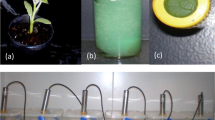Abstract
The influence of transition from night to day temperature 3 h before, 1 h before, 1h after and 3 h after sunrise on the incidence ofDidymella bryoniae was studied both on inoculated and on uninoculated glasshouse-grown cucumber plants. The effect of inoculation on plant growth and fruit production was studied as well.
The later the transition to day temperature took place, the longer were the periods with a high relative air humidity and of condensation of water on fruits.
The time of transition had no effect on plant growth, yield, disease incidence on growing tips, number of lesions on the main stems of uninoculated plants and external fruit rot. The later the transition to day temperature took place, the more lesions on the main stem of inoculated plants appeared and the higher was the incidence of internal fruit rot.
Inoculation of plants increased the number of lesions on the main stem, the disease incidence on growing tips, the production of misshapen fruits and the internal and external fruit rot. The number of secondary side shoots was incrreased but the total number of their internodes was reduced by inoculation.
Inoculation caused an 18% reduction in number of internodes over a period of four weeks and a 10% reduction in number of fruits in the corresponding harvest period.
The consequences of a more humid glasshouse climate and of a high infection pressure ofD. bryoniae for the grower are briefly discussed.
Samenvatting
De invloed van het 3 uur vóór, 1 urr vóór, 1 uur na en 3 uur na zonsopgang overgaan van de nacht-naar de dagtemperatuur op het optreden vanDidymella bryoniae werd zowel op geïnoculleerde als op niet-geïnocullerde planten van kaskomkommers onderzocht. De invloed van inoculatie op de groei van de planten en de produktie van vruchten werd eveneens nagegaan.
Hoe later naar de dagtemperatuur werd overgegaan, hoe langer de perioden met een hoge relatieve luchtvochtigheid waren en hoe langer de perioden waarin condensatie van water op vruchten optrad.
Het tijdstip van overgang had geen effect op de groei van de planten, de opbrengst, de aantasting van groeipunten, het aantal lesies op de hoofdstengel van niet geïnoculeerde planten en uitwendig vruchtrot. Hoe later naar de dagtemperatuur werd overgegaan, hoe meer lesies na vier weken op de hoofdstengel van geïnoculeerde planten en hoe meer vruchten met inwendig rot voorkwamen.
Door inoculatie van de planten nam het aantal lesies op de hoofdstengel, de aantasting van groeipunten, de produktie van stekvruchten en het aantal vruchten met inen uitwendig rot toe. Het aantal zijscheuten van de tweede orde nam toe, maar het totaal aantal internodiën ervan nam door inoculatie af. Inoculatie reduceerde het aantal internodiën met 18% over een periode van vier weken en die van het aantal vruchten met 10% in de overeenkomstige oogstperiode. De praktische consequenties van een
Similar content being viewed by others
References
Fletcher, J.T. & Preece, T.F., 1966.Mycosphaerella stem rot of cucumbers in the Lea Valley. Ann. appl. Biol. 58: 423–430.
Lint, P.J.A.J. de & Heij, G., 1982. Night temperature and flower abortion of glasshouse cucumber (Cucumis sativus L). Neth. J. agric. Sci. 30: 331–339.
Mihara, Y. & Hayashi, M., 1978. Latent heat of water for cooling and dehumidifying ventilation in greenhouses. Acta Hort. 87: 329–336.
Schenck, N.C., 1968. Incidence of airborne fungus spores over watermelon fields in Florida. Phytopathology 58: 91–94.
Steekelenburg, N.A.M. van, 1982. Factors influencing external rot of cucumber caused byDidymella bryoniae. Neth. J. Pl. Path. 88: 47–56.
Steekelenburg, N.A.M. van, 1983. Epidemiological aspects ofDidymella bryoniae, the cause of stem and fruit rot of cucumber. Neth. J. Pl. Path. 89: 75–86.
Steekelenburg, N.A.M. van, 1984. Influence of ventilation temperature and low ventilation rates on incidence ofDidymella bryoniae in glasshouse cucumbers. Acta Hort. 156 (in press).
Steekelenburg, N.A.M. van & Vooren, J. van de, 1981. Influence of the glasshouse climate on development of diseases in a cucumber crop with special reference to stem and fruit rot caused byDidymella bryoniae. Acta Hort. 118: 45–65.
Svedelius, G. & Unestam, T., 1978. Experimental factors favouring infection of attached cucumber leaves byDidymella bryoniae. Trans. Br. mycol. Soc. 71: 89–97.
Vooren, J. van de & Koppe, R., 1975. The climate glasshouse at Naaldwijk. Neth. J. agr. Sci. 23: 238–247.
Author information
Authors and Affiliations
Additional information
Seconded to the Glashouse Crops Research and Experiment Station, Zuidweg 38, 2671 MN Naaldwijk, the Netherlands
Rights and permissions
About this article
Cite this article
Van Steekelenburg, N.A.M. Influence of time of transition from night to day temperature regimes on incidence of Didymella bryoniae and influence of the disease on growth and yield of glasshouse cucumbers. Netherlands Journal of Plant Pathology 91, 225–233 (1985). https://doi.org/10.1007/BF01997966
Accepted:
Issue Date:
DOI: https://doi.org/10.1007/BF01997966




